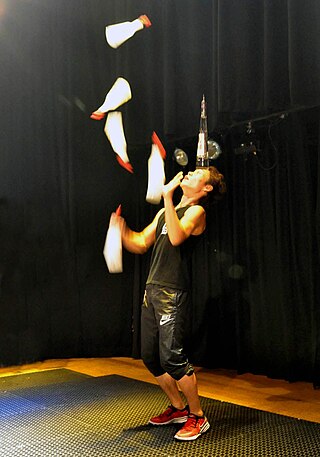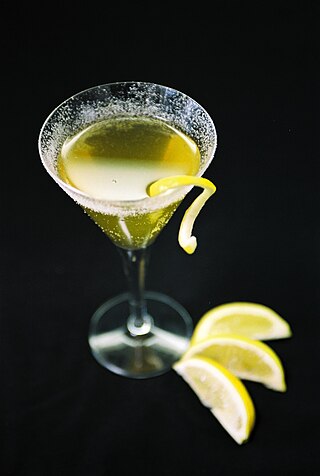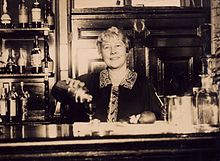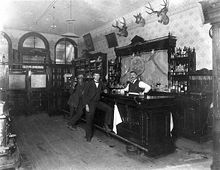
A cocktail is an alcoholic mixed drink or non alcoholic mixed drink. Most commonly, a cocktail is a combination of one or more spirits mixed with other ingredients, such as juices, flavored syrups, tonic water, shrubs, and bitters. Cocktails vary widely across regions of the world, and many websites publish both original recipes and their own interpretations of older and more famous cocktails.

The Long Island iced tea, or Long Island ice tea, is an IBA official cocktail, typically made with vodka, tequila, light rum, triple sec, gin, and a splash of cola. Despite its name, the cocktail does not typically contain iced tea, but is named for having the same amber hue as iced tea.

The martini is a cocktail made with gin and vermouth, and garnished with an olive or a lemon twist. Over the years, the martini has become one of the best-known mixed alcoholic beverages. A popular variation, the vodka martini, uses vodka instead of gin for the cocktail's base spirit.

The term punch refers to a wide assortment of drinks, both non-alcoholic and alcoholic, generally containing fruits or fruit juice. The drink was introduced from the Indian subcontinent to England by employees of the East India Company in the late 17th century. Punch is usually served at parties in large, wide bowls, known as punch bowls.

A Caesar is a cocktail created and consumed primarily in Canada. It typically contains vodka, Clamato, hot sauce, and Worcestershire sauce, and is served with ice in a large, celery salt-rimmed glass, typically garnished with a stalk of celery and wedge of lime. What distinguishes it from a Bloody Mary is the inclusion of clam broth. The cocktail may also be contrasted with the Michelada, which has similar flavouring ingredients but uses beer instead of vodka. Festivals dedicated to the cocktail are held in many cities, with the largest in Calgary. The first liquor store dedicated to the Caesar opened on July 1st 2023 in Calgary AB.

Flair bartending is the practice of bartenders entertaining guests, clientele or audiences with the manipulation of bar tools and liquor bottles in tricky, dazzling ways. Used occasionally in cocktail bars, the action requires skills commonly associated with jugglers. It has become a sought-after talent among venue owners and marketers to help advertise a liquor product or the opening of a bar establishment. Competitions have been sponsored by liquor brands to attract flair bartenders, and some hospitality training companies hold courses to teach flair techniques.

Various unique terminology is used in bartending.

A shooter, or shot, is a small serving of spirits or a mixed drink, typically consumed quickly, often in a single gulp. It is common to serve a shooter as a side to a larger drink.

A Jack Rose is a cocktail containing applejack, grenadine, and lemon or lime juice. It was popular in the 1920s and 1930s, notably appearing in Ernest Hemingway's 1926 classic, The Sun Also Rises, in which Jake Barnes, the narrator, drinks a Jack Rose in the Crillon Paris hotel bar while awaiting the arrival of Lady Brett Ashley. It was also a favorite drink of author John Steinbeck.

A flaming drink is a cocktail or other mixed drink that contains flammable, high-proof alcohol, which is ignited before consumption. The alcohol may be an integral part of the drink, or it may be floated as a thin layer across the top of the drink. The flames are mostly for dramatic flair. However, in combination with certain ingredients, the flavor of the drink is altered. Some flavors are enhanced, and the process may impart a toasted flavor to some drinks.

A woo woo is an alcoholic beverage made of vodka, peach schnapps, and cranberry juice. It is typically served as a cocktail in a highball glass or can be served as a shot. It can also be served in a rocks glass. The ingredients are usually shaken together with ice or stirred as preferred. A lime wedge is used as a garnish.

A Bloody Mary is a cocktail containing vodka, tomato juice, and other spices and flavorings including Worcestershire sauce, hot sauces, garlic, herbs, horseradish, celery, olives, pickled vegetables, salt, black pepper, lemon juice, lime juice and celery salt. Some versions of the drink, such as the "surf 'n turf" Bloody Mary, include shrimp and bacon as garnishes. In the United States, it is usually consumed in the morning or early afternoon, and is popular as a hangover cure.

A Signature drink is any unique or original drink that expresses the nature of the person or establishment creating it.

A lemon drop is a vodka-based cocktail that has a lemony, sweet and sour flavor, prepared using vodka, triple sec, and fresh lemon juice. It has been described as a variant of, or as "a take on", the vodka martini, but is in fact closer to a white lady variant. It is typically prepared and served straight up – chilled with ice and strained.
Bartending school refers to private education businesses that teach individuals the many intricacies of serving customers alcohol from behind a bar. This includes not only classes in such topics as drinks mixology: the intricacies of mixing drinks and drink presentation, and the alcohol laws of the city and state, or province, in which the school is situated.

Ada Coleman (1875–1966) was head bartender at the Savoy Hotel in London for 23 years, one of only two women to have held that position. While working at the Savoy, she invented the "hanky panky", a distinctive variation on the sweet martini cocktail.
Lynnette Marrero is an American bartender, mixologist, and philanthropist known for creating the world's first all-female speed bartending competition, "Speed Rack." She is widely regarded as one of the pioneer female cocktail-specific bartenders in the industry, and is based in New York City.

Juyoung Kang is an American bartender. Kang serves as the head bartender at The Dorsey at The Venetian in Las Vegas, Nevada in the United States. Her work has been featured on KNPR and in The Atlantic, GQ, Food & Wine, Men's Health, ForbesLas Vegas Weekly and Eater. Kang was named "Most Imaginative Bartender of the Year" by the United States Bartenders' Guild and Bombay Sapphire in 2014 and the following year, she was named the Nevada Restaurant Association's Bartender of the Year. She was named one of Wine Enthusiast's top "40 Under 40 Tastemakers" in 2017.
Gary "Gaz" Regan was a British-born bartender and a writer in the United States. He was known for his book The Joy of Mixology.

The craft cocktail movement is a social movement spurred by the cocktail renaissance, a period of time in the 21st century characterized by a revival and re-prioritization of traditional recipes and methods in the bar industry, especially in the United States. The renaissance spanned from the early 2000s into the late 2010s. A stricter range is 2004 to 2017: by 2017, high-quality ingredients, techniques, and liquors began to be ubiquitous in bars across the United States, leading writers to declare the renaissance over.

























